

|
| DEUTSCHLAND | GERMANY |
| Bundesland: Freistaat Sachsen | Saxony |
| kreisfreie Stadt: Dresden |
Dresden is situated at an elevation of 113 m at the river Elbe. Dresden is the capital of Germany's state of Saxony.
With its population of about 490,800 (2005) it is one of the three metropolitan areas that together form the
metropolitan region Sachsendreieck (Dresden, Leipzig-Halle,
and Chemnitz-Zwickau). The city of Dresden is administered as a
district in its own right. The municipality has a population of about 530,000 (2011).
The earliest traces of human settlements date from the Neolithic period. The earliest mention of Dresdene
is found in a document of 1206. The name most probably is derived from the old sorbic word 'Drežďany',
refering to the inhabitants of a lowland forest. Around 1500 Dresden became the residence of
the margraves of Meißen and dukes of Saxony from the Wettin dynasty (see chart of the Wettin dynasty).
The 'Wittenberg Kapitulation' of 1547, which ended the War of Schmalkalden,
transfered the rank of Electors from the Ernestine to the the Albertine line of the dynasty.
Saxony thus became the most influential Protestant country within the Holy Roman Empire.
Under Elector Friedrich August I (King August II of Poland) Dresden became one of the most important cultural
centres of Europe. During the Napoleonic times, Saxony was allied with France. With approval of Napoleon, Saxony was
elevated to a kingdom in 1806. After the defeat of Napoleon in the Battle of Leipzig (1813) and the Congress of
Vienna (1815), the territory of the kingdom was reduced by almost two thirds: its
northern and eastern parts were annexed to Prussia (province Saxony), the Thuringian possessions fell to the
Ernestine Grand Duchy of Saxe-Weimar-Eisenach. Nevertheless, Saxony remained one of the
strongest countries in Europe, even after 1871 when it became part of the German Empire.
After World war I, Dresden became the capital of the Free State of Saxony within the first German Republic.
During World War II Dresden was spared from battles for most of the war. However, on 13/14 February 1945,
the town was almost completely destroyed by a British and American bomb raid. Current estimates calculate the loss of
some 35,000 people. After the war, parts of the historic old town were cleared, the remaining ruins and several churches
were blown up. Some other historic buildings, however, such as the Zwinger, the Hofkirche and the opera house were
restored. After the reunification of Germany in 1990 the efforts to restore parts of the historic appearance were renewed.
The Elbe valley from Übigau Palace and Ostragehege fields in the northwest to the Pillnitz Palace and the Elbe River Island
in the southeast, crowned by the Pillnitz Palace and the centre of Dresden with its numerous monuments and parks
was listed as a UNESCO World Heritage site in 2004 (see also list of other UNESCO heritage sites); however,
the World Heritage Committee in 2009 to remove Germany's Dresden Elbe Valley from UNESCO's World Heritage list due to the building of a
four-lane bridge in the heart of the cultural landscape which meant that the property failed to keep its "outstanding universal value as inscribed".
The
The bottom right picture on glass no. 792 [left] shows the
The three building depicted in the background of the picture on glass no. 1271 [right]
are labeled, from left to right, 'Fernheizwerk' (district heating plant), 'Kgl. Hofoper' (royal opera house), and
'Kgl. Gemäldegalerie' (royal art academy).
The
The
The bottom right picture on glass no. 1575 shows the Catholic Hofkirche (see above).
The top picture on glass no. 2463 [left] shows a view of
The
Dresden
The picture on glass no. 1662 [left] shows the funicular railway which connects Dresdens borough of Loschwitz
with Weißer Hirsch. The funicular was built in 1895.
Draždani
Drážďany
Dresda
Dresde
Dresdeni
Drezda
Drezdenas
Drēzdene
Drezno
Drježdźany
Δρέσδη
Дрезден
Дрэздэн
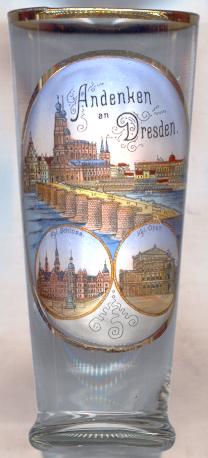 The Catholic
The Catholic  Hofkirche (Court church) [left, no. 792, and right, no. 1055: background left]
was built for Elector Friedrich August II (August III as king of Poland) by the architect Gaetano Chiaveri.
The Baroque church was the largest church of Saxony. The nave has a length of 50 m and a height of 20 m,
the church tower is 85 m tall. Seventy-eight statues of saints were created by Lorenzo Mattielli for the ballustrade
around the nave. The organ was created in 1755 by the famous organ-builder Gottfried Silbermann. The crypt
beneath the church holds the tombs of members of the Wettin dynasty. After its destruction in 1945, the church was
restored until 1965. In 1980 it obtained the status of a cathedral, the new seat of the bishops of the diocese
Dresden-Meißen.
Hofkirche (Court church) [left, no. 792, and right, no. 1055: background left]
was built for Elector Friedrich August II (August III as king of Poland) by the architect Gaetano Chiaveri.
The Baroque church was the largest church of Saxony. The nave has a length of 50 m and a height of 20 m,
the church tower is 85 m tall. Seventy-eight statues of saints were created by Lorenzo Mattielli for the ballustrade
around the nave. The organ was created in 1755 by the famous organ-builder Gottfried Silbermann. The crypt
beneath the church holds the tombs of members of the Wettin dynasty. After its destruction in 1945, the church was
restored until 1965. In 1980 it obtained the status of a cathedral, the new seat of the bishops of the diocese
Dresden-Meißen.
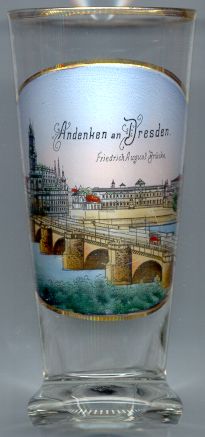 The bridge,
The bridge,  August-Brücke [left] was built in 1727–1731
by the famous Baroque architect Matthäus Daniel Pöppelmann. It was named for Friedrich August I (August 'the Strong').
By the beginning of the 20th century, the bridge could not accomodate the increasing traffinc any more. It was torn
down in 1907 and was replaced by the new
August-Brücke [left] was built in 1727–1731
by the famous Baroque architect Matthäus Daniel Pöppelmann. It was named for Friedrich August I (August 'the Strong').
By the beginning of the 20th century, the bridge could not accomodate the increasing traffinc any more. It was torn
down in 1907 and was replaced by the new  Friedrich-August-Brücke
Friedrich-August-Brücke Royal castle [left, no. 792: bottom left picture]
was first mentioned in 1237. The tower, Hausmannsturm, in the northwestern corner was added around 1400.
Further parts of the castle were added in 1468–1480, 1548–1556, 1586–1591 and 1589–1594.
Parts of the castle which were destroyed by a fire in 1701 were rebuilt between 1717 and 1719. The Lutheran
court chapel was dissolved in 1737 when Friedrich August I ('the Strong') wanted to be elected King of Poland
and because of that converted to the Catholic faith. In 1889–1901 the castle was remodeled in Renaissance revival
style on the occasion of the celebrations of the 800th anniversary of the Wettin dynasty. On 13 February 1945 the castle
was completely destroyed by fire. Works to rebuild the castle began in 1985 and are completed in 2006.
Royal castle [left, no. 792: bottom left picture]
was first mentioned in 1237. The tower, Hausmannsturm, in the northwestern corner was added around 1400.
Further parts of the castle were added in 1468–1480, 1548–1556, 1586–1591 and 1589–1594.
Parts of the castle which were destroyed by a fire in 1701 were rebuilt between 1717 and 1719. The Lutheran
court chapel was dissolved in 1737 when Friedrich August I ('the Strong') wanted to be elected King of Poland
and because of that converted to the Catholic faith. In 1889–1901 the castle was remodeled in Renaissance revival
style on the occasion of the celebrations of the 800th anniversary of the Wettin dynasty. On 13 February 1945 the castle
was completely destroyed by fire. Works to rebuild the castle began in 1985 and are completed in 2006.
 royal
royal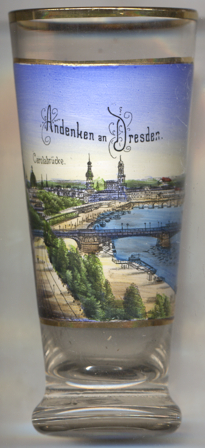
 Carolabrücke (Carola Bridge) [near left, no. 4691, and below, no. 3811: foreground]
is named for Carola of Wasa-Holstein-Gottorp (1833–1907), spouse of King Albert of Saxony and last queen of
Saxony. The first Carola Bridge (depicted on glass no. 3811) was built in 1892–1895. On 7 May 1945, just
one day before the end of World War II, the bridge was blown up by German forces. As the damages were substantial, no
plans were made to reconstruct the bridge after the war according to the old design. Remaining parts of the old bridge were
removed in 1952. The last remnants of the old bridge, two central pillars, were only removed in 1952, when today's bridge
was constructed in 1967–1971.
[https://de.wikipedia.org/wiki/Carolabrücke_(Dresden)]
Carolabrücke (Carola Bridge) [near left, no. 4691, and below, no. 3811: foreground]
is named for Carola of Wasa-Holstein-Gottorp (1833–1907), spouse of King Albert of Saxony and last queen of
Saxony. The first Carola Bridge (depicted on glass no. 3811) was built in 1892–1895. On 7 May 1945, just
one day before the end of World War II, the bridge was blown up by German forces. As the damages were substantial, no
plans were made to reconstruct the bridge after the war according to the old design. Remaining parts of the old bridge were
removed in 1952. The last remnants of the old bridge, two central pillars, were only removed in 1952, when today's bridge
was constructed in 1967–1971.
[https://de.wikipedia.org/wiki/Carolabrücke_(Dresden)]
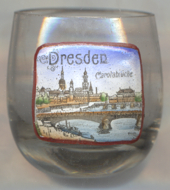
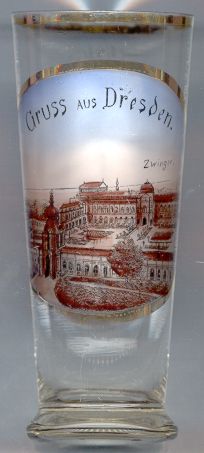
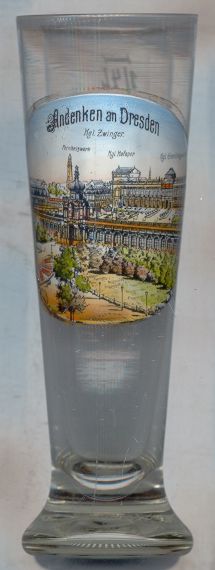
The  Zwinger [left, no. 1238, and right, no. 1271]
is probably Dresden's mot famous historic building. It was designed by the architects Matthäus Daniel Pöppelmann
and Balthasar Permoser, and was built between 1711 and 1728 on the site of a part of the old fortifications.
The Zwinger remained unfinished at first. The wing facing the Elbe river was added only in 1847–1854.
On 13 February 1945 the Zwinger was severely hit by bombs. Original plans called for a removal of the historic structure,
but the population of Dresden wanted to keep it. The restoration began already in 1945/1946. Between 1951 and 1954
the Kronentor (Crown Gate), the Glockenspielpavillon and the Mathematical-Physical Salon were reconstructed, the
restoration was factually completed in 1963.
Zwinger [left, no. 1238, and right, no. 1271]
is probably Dresden's mot famous historic building. It was designed by the architects Matthäus Daniel Pöppelmann
and Balthasar Permoser, and was built between 1711 and 1728 on the site of a part of the old fortifications.
The Zwinger remained unfinished at first. The wing facing the Elbe river was added only in 1847–1854.
On 13 February 1945 the Zwinger was severely hit by bombs. Original plans called for a removal of the historic structure,
but the population of Dresden wanted to keep it. The restoration began already in 1945/1946. Between 1951 and 1954
the Kronentor (Crown Gate), the Glockenspielpavillon and the Mathematical-Physical Salon were reconstructed, the
restoration was factually completed in 1963.
 Fernheizwerk was built in 1900/1901 and was the first of its kind in Europe.
Fernheizwerk was built in 1900/1901 and was the first of its kind in Europe.
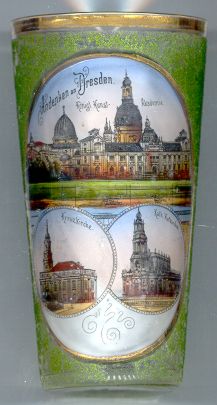
The  Royal Art Academy (Königliche Kunstakademie) [left, no. 1575: top picture]
was built in 1887–1894 by Constantin Lipsius at the Brühlsche Terrasse. The academy was founded in 1764 and is
one of the oldest institutions of its kind in Europe. Today, the building belongs to the university of fine arts of Dresden.
Royal Art Academy (Königliche Kunstakademie) [left, no. 1575: top picture]
was built in 1887–1894 by Constantin Lipsius at the Brühlsche Terrasse. The academy was founded in 1764 and is
one of the oldest institutions of its kind in Europe. Today, the building belongs to the university of fine arts of Dresden.
 Kreuzkirche (Church of the Holy Cross) [left, no. 1575: bottom left picture]
is the second-oldest church of Dresden. The earliest chapel at this place may have existed already prior to 1206.
A Romanesque church dedicated to St. Michael was built in 1215. After 1388 the original name 'Nikolaikirche' was
slowly replaced by its new name, 'Kreuzkirche'. In 1539 the church became Protestant.
The church burnt out five times during its history. In 1491 and 1669
the cause of the fire remained unknown, the third fire in 1760 was caused by a Prussian cannonball.
After that it was rebuilt in 1764 in Baroque style. After another fire in 1897 it was restored and Art Nouveau elements
were added. After the bomb raid on 13 February 1945 the church burnt out again, only the walls remained standing.
The reconstruction was completed 10 years later. The church today is the seat of the Protestant bishop of Saxony.
The church also is home of the world-famous Kreuzchor, one of the oldest boys choirs of Germany, founded in the 13th century.
Kreuzkirche (Church of the Holy Cross) [left, no. 1575: bottom left picture]
is the second-oldest church of Dresden. The earliest chapel at this place may have existed already prior to 1206.
A Romanesque church dedicated to St. Michael was built in 1215. After 1388 the original name 'Nikolaikirche' was
slowly replaced by its new name, 'Kreuzkirche'. In 1539 the church became Protestant.
The church burnt out five times during its history. In 1491 and 1669
the cause of the fire remained unknown, the third fire in 1760 was caused by a Prussian cannonball.
After that it was rebuilt in 1764 in Baroque style. After another fire in 1897 it was restored and Art Nouveau elements
were added. After the bomb raid on 13 February 1945 the church burnt out again, only the walls remained standing.
The reconstruction was completed 10 years later. The church today is the seat of the Protestant bishop of Saxony.
The church also is home of the world-famous Kreuzchor, one of the oldest boys choirs of Germany, founded in the 13th century.

 Postplatz,
Postplatz, Sophienkirche (church of St. Sophia), the only Gothic church of Dresden, stood in the northeast corner of Postplatz.
In 1250 the The Order of Friars Minor, Franciscans, built a monastery and a small church at this location.
In 1331 the church was enlarged and then had two naves and two identical apses. In its southeast corner, the private Busmann chapel was added around 1400.
After the Reformation the church stood empty for several decades until it was reopened as a Lutheran church in 1610 upon an initiative by
Sophie of Brandenburg, wife of Elector Christian I of Saxony.
From 1737 onward, the church served as the Lutheran court chapel. The organ built in 1718–1720 was created by Gottfried Silbermann.
Wilhelm Friedemann Bach was organist at St. Sophia's between 1733 and 1746. His father, Johann Sebastian Bach, also played the organ several times.
The delicate sandstone pyramidal tower roofs were replaced by massive copper roofs in the 1934.
The church was completely demolished during the Allied bomb raid in the night of 13th February, 1945. Everything in the church, including the
magnificent organ, was destroyed by fire. The vaulting withstood the fire, but finally collapsed in the following year.
The remaining south spire was blown up in 1950, the remaining ruins were pulled down in 1962/1963.
Sophienkirche (church of St. Sophia), the only Gothic church of Dresden, stood in the northeast corner of Postplatz.
In 1250 the The Order of Friars Minor, Franciscans, built a monastery and a small church at this location.
In 1331 the church was enlarged and then had two naves and two identical apses. In its southeast corner, the private Busmann chapel was added around 1400.
After the Reformation the church stood empty for several decades until it was reopened as a Lutheran church in 1610 upon an initiative by
Sophie of Brandenburg, wife of Elector Christian I of Saxony.
From 1737 onward, the church served as the Lutheran court chapel. The organ built in 1718–1720 was created by Gottfried Silbermann.
Wilhelm Friedemann Bach was organist at St. Sophia's between 1733 and 1746. His father, Johann Sebastian Bach, also played the organ several times.
The delicate sandstone pyramidal tower roofs were replaced by massive copper roofs in the 1934.
The church was completely demolished during the Allied bomb raid in the night of 13th February, 1945. Everything in the church, including the
magnificent organ, was destroyed by fire. The vaulting withstood the fire, but finally collapsed in the following year.
The remaining south spire was blown up in 1950, the remaining ruins were pulled down in 1962/1963.
 Schloss Albrechtsberg (also called Albrechtschloss, Albrecht Palace) [bottom left]
is one of the famous three Elbe palaces on the right bank of the river.
The palace was built in 1850–1854 by Adolf Lohse for Prince Albrecht, the youngest brother of the Prussian kings Friedrich Wilhelm IV and Wilhelm I
(the later German Emperor Wilhelm II). Albrecht moved to Dresden because the royal court did not accept his presence any more
after his morganatic second marriage to Rosalie von Rauch (later styled Countess of Hohenau; daughter of the Prussian general Gustav von Rauch).
The park of the palace was designed by Eduard Neide and laid out by Hermann Sigismund Neumann.
Schloss Albrechtsberg (also called Albrechtschloss, Albrecht Palace) [bottom left]
is one of the famous three Elbe palaces on the right bank of the river.
The palace was built in 1850–1854 by Adolf Lohse for Prince Albrecht, the youngest brother of the Prussian kings Friedrich Wilhelm IV and Wilhelm I
(the later German Emperor Wilhelm II). Albrecht moved to Dresden because the royal court did not accept his presence any more
after his morganatic second marriage to Rosalie von Rauch (later styled Countess of Hohenau; daughter of the Prussian general Gustav von Rauch).
The park of the palace was designed by Eduard Neide and laid out by Hermann Sigismund Neumann.
 Ständehaus (House of the Estates) [bottom right]
was built in 1901–1906 by the Paul Wallot (who is best known as the architect of the Reichstag in Berlin).
The building replaced the old palace of Count Heinrich von Brühl, which prior to that stood at this site. Between 1907 and 1934 the
Ständehaus served as the seat of the Saxon parliament. In 1945 it was destroyed by Allied bombs. The building was rebuilt after a
more simple design in 1946. Until 1999 it was home to the State Museum for Zoology, the State Museum for Mineralogy and Geology, the German Photograph Collection
and the State Office for the Preservation of Historical Monuments. In 1999 the building became the new seat of the Appellate Court (Oberlandesgericht) of Saxony.
Ständehaus (House of the Estates) [bottom right]
was built in 1901–1906 by the Paul Wallot (who is best known as the architect of the Reichstag in Berlin).
The building replaced the old palace of Count Heinrich von Brühl, which prior to that stood at this site. Between 1907 and 1934 the
Ständehaus served as the seat of the Saxon parliament. In 1945 it was destroyed by Allied bombs. The building was rebuilt after a
more simple design in 1946. Until 1999 it was home to the State Museum for Zoology, the State Museum for Mineralogy and Geology, the German Photograph Collection
and the State Office for the Preservation of Historical Monuments. In 1999 the building became the new seat of the Appellate Court (Oberlandesgericht) of Saxony.
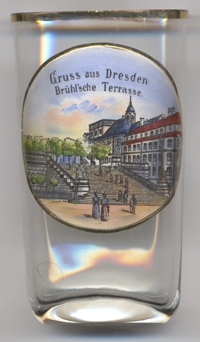
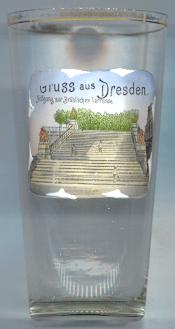
The  Brühlsche Terrasse [left, no. 4894, and right, no. 730],
situated at the left bank of the Elbe river, is one of Dresden's architectural highlights.
Its name goes back to prime minister Count Heinrich von Brühl, who had his Palais built at this place in 1737. Brühl introduced
the 'Generalkonsumakzise', the forerunner of the value added tax. In 1747 he received the whole
terrace as a reward which then became known as 'Brühlscher Garten'. The staircase depicted on glass no. 730
[left] was created around 1880.
Brühlsche Terrasse [left, no. 4894, and right, no. 730],
situated at the left bank of the Elbe river, is one of Dresden's architectural highlights.
Its name goes back to prime minister Count Heinrich von Brühl, who had his Palais built at this place in 1737. Brühl introduced
the 'Generalkonsumakzise', the forerunner of the value added tax. In 1747 he received the whole
terrace as a reward which then became known as 'Brühlscher Garten'. The staircase depicted on glass no. 730
[left] was created around 1880.
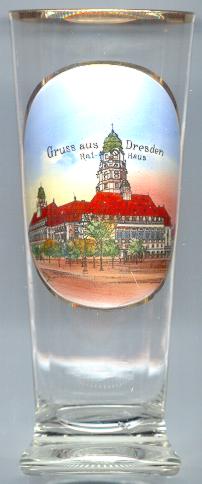
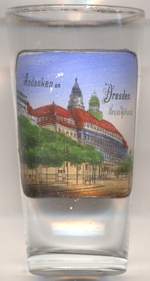
The  New Town Hall (Neues Rathaus) [left, no. 716, and right, no. 4097]
is the seat of the municipal administration of Dresden. The building was designed by Carl Roth and Edmund Bräter
and was built between 1905 and 1910. The characteristic tower has a height of 100 metres. The statue on top of the
tower, a guilded sheet copper statue created by Richard Guhr, has a height of 5 metres.
The town hall was partly destroyed in 1945 and was restored after the war.
New Town Hall (Neues Rathaus) [left, no. 716, and right, no. 4097]
is the seat of the municipal administration of Dresden. The building was designed by Carl Roth and Edmund Bräter
and was built between 1905 and 1910. The characteristic tower has a height of 100 metres. The statue on top of the
tower, a guilded sheet copper statue created by Richard Guhr, has a height of 5 metres.
The town hall was partly destroyed in 1945 and was restored after the war.
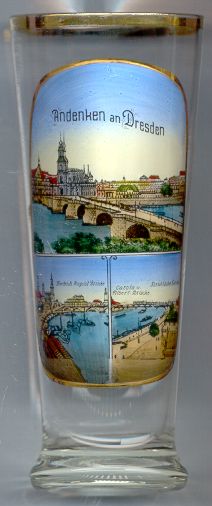
Glass no. 1208 [left] shows a view of the Catholic Hofkirche and Friedrich-August-Brücke [top],
the Elbe river with royal opera house in the background and another view of the Friedrich-August-Brücke [bottom left],
and a view of the Elbe and Brühlsche Terrasse with the bridges Carolabrücke and Albertbrücke [bottom right].

 Central Station (Hauptbahnhof) [left]
s the largest passenger station in Dresden. In 1898, it replaced the Böhmischer Bahnhof ("Bohemian station") of the
former Saxon-Bohemian State Railway (Sächsisch-Böhmische Staatseisenbahn), and was designed with its formal layout
as the central station of the city. The combination of a station building on an island between the tracks and a terminal
station on two different levels is unique. The building is notable for its halls that are roofed with Teflon-coated glass
fibre membranes. This translucent roof design, installed during the comprehensive rehabilitation of the station at the
beginning of the 21st century, allows more daylight to reach the concourses than was previously possible.
[https://en.wikipedia.org/wiki/Dresden_Hauptbahnhof]
Central Station (Hauptbahnhof) [left]
s the largest passenger station in Dresden. In 1898, it replaced the Böhmischer Bahnhof ("Bohemian station") of the
former Saxon-Bohemian State Railway (Sächsisch-Böhmische Staatseisenbahn), and was designed with its formal layout
as the central station of the city. The combination of a station building on an island between the tracks and a terminal
station on two different levels is unique. The building is notable for its halls that are roofed with Teflon-coated glass
fibre membranes. This translucent roof design, installed during the comprehensive rehabilitation of the station at the
beginning of the 21st century, allows more daylight to reach the concourses than was previously possible.
[https://en.wikipedia.org/wiki/Dresden_Hauptbahnhof]

The view depicted on glass no. :4909 [near left] is labelled Dampfschifflandeplatz (steamboat landing place).
The Sächsische Dampfschiffahrt is the oldest and biggest paddle steamer fleet in the world. The very first steam ship arrived at
Dresden in 1835. The Elbdampfschiffahrts-Gesellschaft (Elbe Steamboat Company) was founded in 1836, since 1939 operating under
the name Königlich privilegierte Sächsische Dampfschiffahrts-Gesellschaft (Roxal Privileged Saxon Steamship Company). In
1849 the company was merged with the Austrian 'K.K. priv. Dampfschiffahrt' (Imperial-Royal privileged Steamship Company) and since
then operated under the name Sächsisch-Böhmische Dampfschiffahrts-Gesellschaft (SBDG) (Saxon-Bohemian Steamship Company).
In 1923 it merged with the 'Neue Deutsch-Böhmische Elbeschiffahrt Aktiengesellschaft (NDBE)' (New German-Bohemian Elbe Shipping Company)
and the new Sächsisch-Böhmische-Dampfschiffahrt, Aktiengesellschaft (SDBA) (Saxon-Bohemian Steamship Company, public limited company)
was founded. the company was nationalised in 1947 under the name VEB (Volkseigener Betrieb) Elbeschiffahrt Sachsen, wihch in 1950
was merged into the VEB Elbeschiffahrt Sachsen, but was separated from it again in 1952. After the Re-unification of Germany
all ships became a property of the free State of Saxony, which sold the company to a private company in 1992. The remaining ships, among
them 10 historic boats, where taken over by the newly founded Sächsische Dampfschiffahrts GmbH & Co. Conti Elbschiffahrts KG.
To ensure continued operation, the Weiße Flotte Sachsen GmbH ('White Fleet Saxony Litd.') was founded in 2020. The nine historic
paddle steamers, which are listed, became the property of 'Kulturerbe Dampfschiffe Dresden GmbH' ('Cultural heritage steamboats dresden'),
a company founded specifically for this purpose in 2020.
[https://en.wikipedia.org/wiki/S%C3%A4chsische_Dampfschiffahrt, https://en.wikipedia.org/wiki/S%C3%A4chsische_Dampfschiffahrt]
Weißer Hirsch
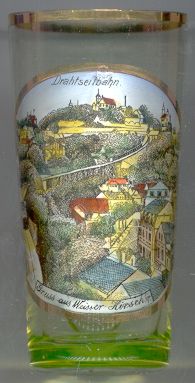 Weißer Hirsch is a city borough of Dresden.
The area was first mentioned in 1420 when a piece of forest was donated to the monks of the Augustine monastery.
Part of Weißer Hirsch today still is called 'Mönchsholz' ('Monks' Wood'). In 1685 a country inn of the name
'Weißer Hirsch' (literally 'White Stag') was opened. In 1839 the village obtained the status of a
rural community. In 1867 a bath house was opened and started the tradition of Weißer Hirsch as a regional spa
place. The sanatorium was founded in 1888 and the village soon obtained a more town-like character.
In 1921 the spa town Weißer Hirsch was incorporated, against the will of its inhabitnats, into the
municipality of Dresden.
Weißer Hirsch is a city borough of Dresden.
The area was first mentioned in 1420 when a piece of forest was donated to the monks of the Augustine monastery.
Part of Weißer Hirsch today still is called 'Mönchsholz' ('Monks' Wood'). In 1685 a country inn of the name
'Weißer Hirsch' (literally 'White Stag') was opened. In 1839 the village obtained the status of a
rural community. In 1867 a bath house was opened and started the tradition of Weißer Hirsch as a regional spa
place. The sanatorium was founded in 1888 and the village soon obtained a more town-like character.
In 1921 the spa town Weißer Hirsch was incorporated, against the will of its inhabitnats, into the
municipality of Dresden.
![[scale]](lineal.jpg)